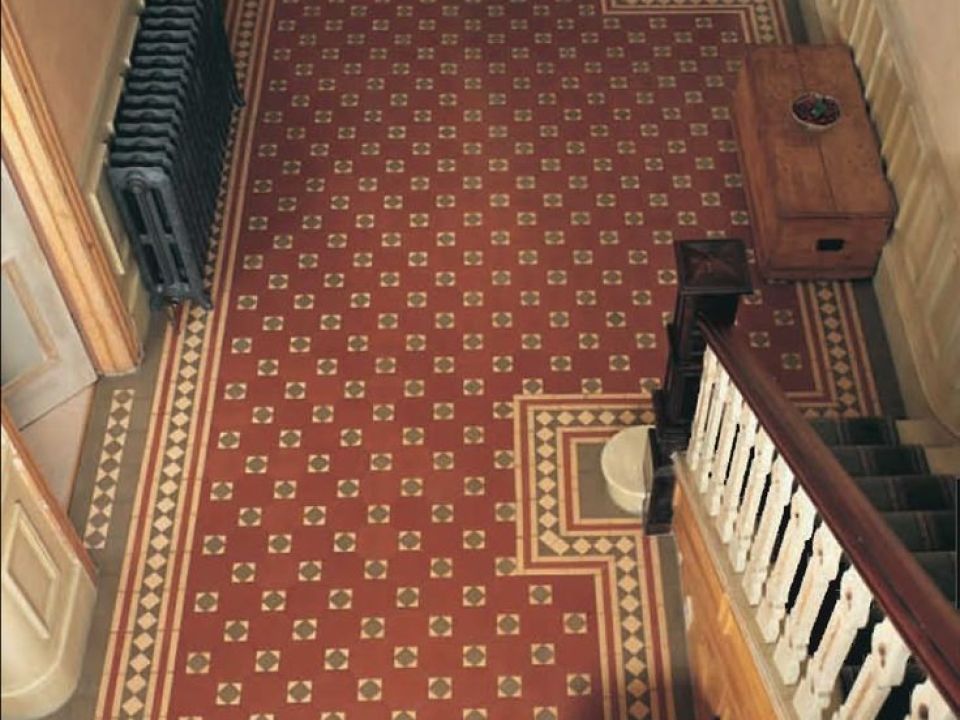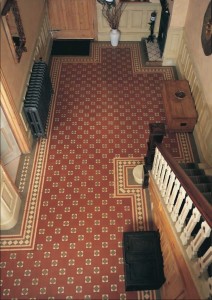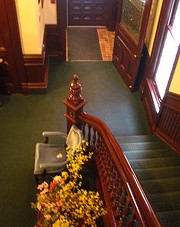Reviving your Victorian entrance hall

 As the area where their esteemed guests would be welcomed, the Victorians regarded the entrance hall as a very important part of their home, and would often use this space to demonstrate both their wealth and good taste. Today, it is the most common area where original features can be found, and it is worth investing the time and money in restoring these to their former glory. If you are thinking of restoring your Victorian entrance hall, read through our tips for bringing back the beauty in your tiles, walls, door, lighting, stairs and radiator:
As the area where their esteemed guests would be welcomed, the Victorians regarded the entrance hall as a very important part of their home, and would often use this space to demonstrate both their wealth and good taste. Today, it is the most common area where original features can be found, and it is worth investing the time and money in restoring these to their former glory. If you are thinking of restoring your Victorian entrance hall, read through our tips for bringing back the beauty in your tiles, walls, door, lighting, stairs and radiator:
Tiles:
If you are lucky enough to have authentic Victorian tiles in your entrance hall (and it is worth carefully prizing up modern floor coverings to check), spending some time restoring them is a worthwhile project as a restored tiled floor provides a stunning focal point for your Victorian home. The beauty of these tiles is usually hidden underneath years of neglect and grime, but using modern day products and a lot of elbow grease, you can bring them back to their former glory. The first job is to remove any carpet gripper strips that have been used to cover up the floor. This is a delicate job as you don't want to further damage the tiles in the process. Then, you need to wash the floor clean. A lot of modern cleaning products will damage and dull your floor so be careful what you use. The Tile Doctor's Pro-clean & Ultra clean products are a good choice to get off built up grime. Be aware that after applying them it can take a long time for the floor to dry properly before you can seal it, so you will need something to cover it (large sheets of card for example) so people can walk over it without getting it dirty again. You'll then need to repair any broken tiles: there are plenty of companies offering reproductions, Walls & Floors (Kettering) Ltd and European Heritage being two popular options. Finally once dry and repaired, the floor will need to be sealed using a product like the Tile Doctor's Seal & Go. This requires a lot of coating and recoating, and a lot of drying time - so you will need to plan for everyone being out of the house for the duration of the drying time and be ready to cover the floor between coats. This is of course just a rough guide suitable for a floor that hasn't sustained too much damage, and the exact restoration process depends on your individual floor. The process sounds long-winded but the results can be amazing and your restored floor will really add to the saleability of your Victorian home.Walls:
Typically a Victorian hallway would have as many as three colours on the walls. The woodwork, including skirting and dado, would be a dark stain or painted white. A lighter colour would have been chosen for above the dado. Finally, below the dado, one of the many popular wallpapers would be selected, and where the walls were in poor condition, a textured wallpaper would be chosen and painted over once hung. Popular colour choices were shades of burgundy, red and terracotta. Take care if you are stripping away very old authentic Victorian wallpaper as it can pose a huge health risk. Victorians loved wallpaper that was painted in Scheele's Green and this brilliant colour was made from copper arsenite. Although the green wallpaper was the most popular and therefore the biggest culprit, arsenic was also found in other colours of paper: gray, white, blue, pink, yellow and brown. If you are dealing with removing any original paper, it is worth contacting an expert as exposure to even a very small amount of the affected paper can result in a fatal illness.Front doors:
Victorian front doors typically featured beautiful stained glass panels that allow light to flood into the entrance hall. They would often be painted a rich red, deep green or glossy black, and be set off with complementing brass door furniture which would include a knocker, letter plate, knob and bell push. Many would feature beautiful glass fanlights above the door allowing further light into the hallway. If you are restoring your Victorian home, you will likely find that your door is covered in many coats of paint and its best features are probably hidden from view. You have a number of options here: the first is to get the door dipped, the second is to remove the paint using other methods, and the third is to replace it. Dipping sounds like a cheap option but it is actually a lot of work. You first need to remove the door from its hinges and strip down all of the door furniture. This can be tricky because of the paint build-up and can take a long time. You then need to transport it to where it will be dipped - bear in mind that these old doors are usually very heavy, so you will need a van ideally. When the door is dipped into chemicals, the moisture content in the wood increases and you run the risk of the door splitting and warping which can ruin it forever. So while dipping looks like a cheap quick option, it can result in a lot of work and a lot of damage if it goes wrong. The second option is to remove the paint using other methods. If your house was built prior to the 1960s, there's a good chance that some of the paint contains lead and it is extremely hazardous to try and remove it yourself, for example by heat gun. You should instead contact an expert who can test for lead and remove the paint at a cost of about £35 per square metre. It is worth noting that if you do have a door coated up with paint and this is flaking away, it is important to take action as even small flakes containing lead can pose a serious health risk. The final option is to replace the door. When you add up the cost of labour and the time involved in the other methods, this option can surprisingly can be the cheapest and usually offers the best results. A bespoke Victorian door will be a beautiful addition to your Victorian home and will be the pièce de résistance of your Victorian hallway.Interior doors:
Most entrance halls will have a number of adjacent rooms and it is worth paying attention to the interior doors. Victorian interior doors would tend to be solid wood with four, six or eight panels and would usually be stained dark or painted white to match the other wood in the home.Lighting:
By the end of the Victorian era, electric lighting was still relatively new and gas lighting would have been more common even in large towns and cities, with candles and oil lamps. In the modern home, practicalities usually demand selecting Victorian-inspired pieces that take design cues from the era. Brass is usually the metal of choice, and a popular option is to use a hallway lantern, perhaps with stained glass panels. Pendant lights that are reminiscent of paraffin oil lamps are also a good pick if it is an authentic look that you are shooting for.Stairs:
 To bring back the Victorian look to your staircase, consider stripping down the balustrade and painting the individual balusters white, or leave the whole balustrade stripped and stain it in a dark finish. You have a number of options for the stairs themselves. If the wood is in very good condition, strip off any old paint, stain and varnish the treads and paint the rises white. If the wood is worn in the centre as it often is, stain both the treads and rises, and install a carpet runner up the centre. Carpet rods are a really attractive way to finish the look and sets are available on eBay for around £65.00.
To bring back the Victorian look to your staircase, consider stripping down the balustrade and painting the individual balusters white, or leave the whole balustrade stripped and stain it in a dark finish. You have a number of options for the stairs themselves. If the wood is in very good condition, strip off any old paint, stain and varnish the treads and paint the rises white. If the wood is worn in the centre as it often is, stain both the treads and rises, and install a carpet runner up the centre. Carpet rods are a really attractive way to finish the look and sets are available on eBay for around £65.00.
Radiator:
Victorian radiators would have been cast iron and range from the heavy plain designs to the very ornate. Many Victorian radiators have been replaced with modern alternatives, but fortunately imitations are cheaply available and are worth the small investment in bringing a final touch of authenticity to your hallway. An alternative to replacing your modern radiator is to use a Victorian-inspired radiator cover, usually painted white or stained dark to match the other wood in the entrance hall. As with the doors, be careful of stripping paint from authentic Victorian radiators, they may contain lead. Image credits: Hallway image sourced via Pinterest. Victorian wallpapers: Sarah Nitt, Dorret & Bosc d'Anjou. Stairway: Anz-i Elevate Your Property with Heritage Craftsmanship
Looking to enhance your period home with bespoke craftsmanship? At Old English Doors, we specialise in creating custom wooden doors, windows, porches, and more - designed to reflect your home’s unique charm. Contact us today for a personalised quote and bring timeless elegance to your property.